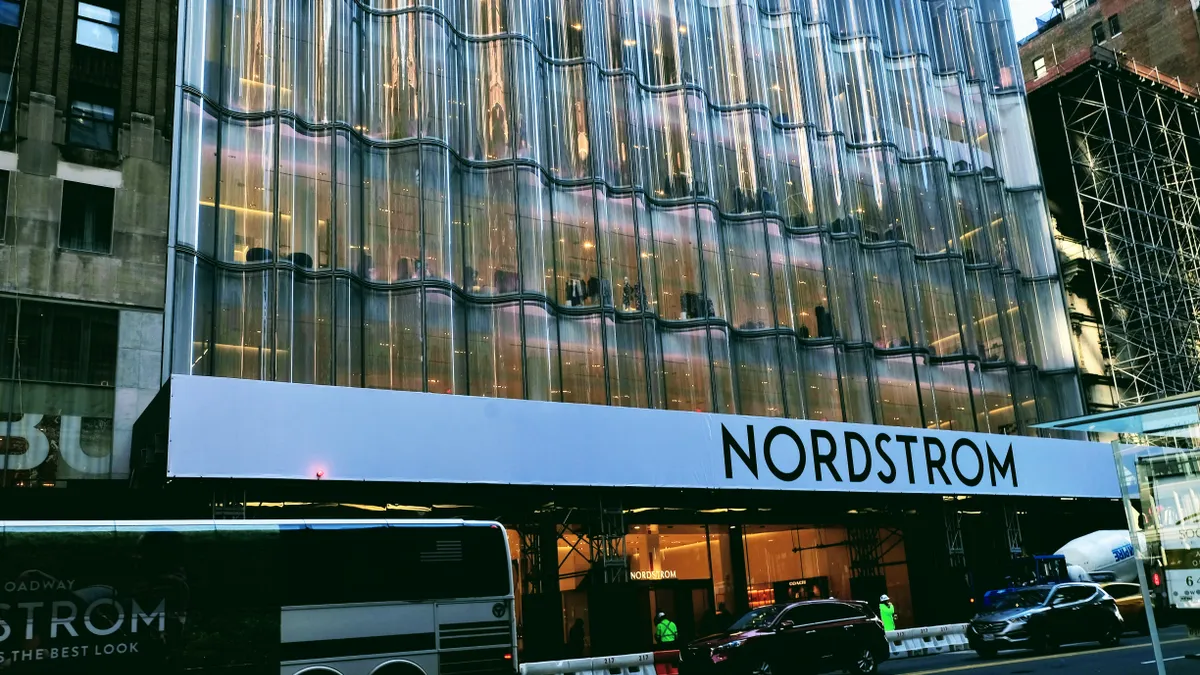Dive Brief:
-
The effect of Nordstrom's decision last year to close 16 full-line stores was felt during its first quarter, when net sales rose 44% from 2020, but fell 13% from 2019. Year over year, full-line store sales rose 37% and off-price Rack sales rose 59%; compared to 2019, sales at each fell 13%.
-
E-commerce sales were up 23% year over year and 28% compared to 2019, and accounted for 46% of the period's total sales, according to a company press release. Ending inventory was down 2% compared with the same quarter two years ago, the company said.
-
Nordstrom remained in the red but narrowed its net loss to $166 million from $521 million a year ago. Year over year, gross profit expanded about 2,000 basis points to 31% of net sales, but was down 260 basis points compared with 2019 due to "lower sales and lower merchandise margins, partially offset by permanent reductions in buying and occupancy costs."
Dive Insight:
Nordstrom's first quarter report didn't reflect the kind of rebound seen at Macy's, Dillard's or Kohl's, but, while a few analysts were disappointed in the department store's performance in the period, many also see room for improvement this year.
The retailer differs from its peers in a few ways. One is that its wealthier customer base didn't receive the level of financial relief that many consumers have throughout the pandemic, Credit Suisse analyst Michael Binetti said in a Tuesday client note.
Another is that Nordstrom appears to have struggled more with inventory, perhaps because both of its businesses traditionally sell dressier apparel than what was in demand over the last year and because home goods, which were in demand, is not its bailiwick. The retailer is addressing that, but CEO Erik Nordstrom also said that demand is shifting again, back toward its strengths, with traffic up in stores without dropping online, and "momentum across the board."
"We're a bit unique in our mix and also our geographic footprint, and our big markets and many of our big categories really had a disproportionate amount of headwinds during the pandemic, and there are signs of that turning," Nordstrom said. "People are starting to get out ... we're hearing a lot from customers about weddings this summer. It's not necessarily buying suits to go back to the office in, but dresses, handbags, anything to get out, it could be to a restaurant, it could be on a trip."
The company's decision to significantly trim its brick-and-mortar footprint demonstrates how important even underperforming stores are to sales.
"We believe that the recovery will continue to gather steam, especially as Nordstrom now seems to have pivoted to a more casual assortment in its stores," GlobalData Managing Director Neil Saunders said in emailed comments. "That said, there is still work to do in building a more compelling range that moves beyond apparel and has a greater emphasis on new, innovative and exclusive brands. We see this as being critical to differentiate and to drive footfall."
Nordstrom apparently hopes to make up for the loss of sales in stores with a new strategy to goose its digital sales. Executives on Tuesday reiterated their plan, unveiled earlier this year, to dramatically expand its online offer from about 300,000 items to more than 1.5 million over the next three to five years, via what they're calling a "digital-first" platform. That entails new ways of working with suppliers, including a drop-ship model that Nordstrom President and Chief Brand Officer Pete Nordstrom on Tuesday said is especially helpful in expanding what the company is calling "choice count," while sharing more risk with vendors.
The tactic allowed the retailer to quickly ramp up its home category offer over the last 18 months and has been key in preparing for Nordstrom's upcoming anniversary sale, Nordstrom said. Some analysts hailed the growth opportunity, but GlobalData's Saunders believes the expansion plan and its drop-ship model are risky.
"In our view, selective range expansion is prudent, [but] exponential expansion runs the risk of confusing customers and making Nordstrom's digital presence like any other marketplace," Saunders said. "If it is about anything, Nordstrom should be about curation and differentiation, so we believe this is a step in the wrong direction."
Another way Nordstrom is expanding its digital offer is through what it calls its market strategy, which entails melding its full-line, Rack, Local and online operations in key markets. In the last three months, Nordstrom rolled out the approach to Atlanta, Houston, Detroit and Minneapolis, and it's now in place in the company's top 20 markets, which account for 75% of its sales, Erik Nordstrom said.















